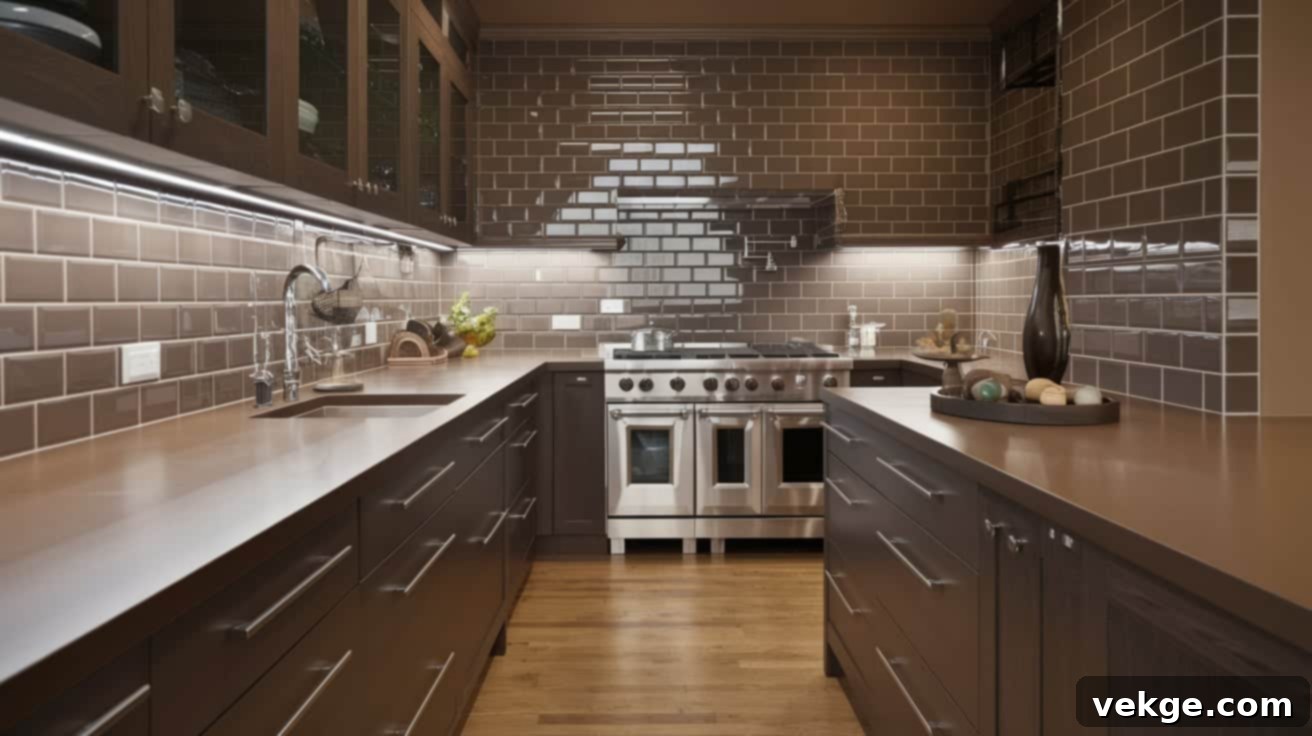Unveiling Taupe Kitchen Backsplash Tiles: The Ultimate Guide to Timeless Style and Versatility
When embarking on a kitchen renovation or simply looking to refresh your space, the choice of backsplash can profoundly impact the overall aesthetic. Among the myriad options available, taupe kitchen backsplash tiles stand out as a remarkably versatile and classic selection. This sophisticated neutral hue effortlessly bridges the gap between modern minimalism and traditional warmth, making it a perfect fit for almost any design vision.
This comprehensive guide will delve into why taupe is an exceptional choice for your kitchen backsplash, exploring the numerous benefits it offers, from its inherent versatility to its low-maintenance appeal. We’ll also provide practical advice on installation for DIY enthusiasts, present a wealth of design ideas to spark your creativity, and share essential tips for maintaining its pristine look. Whether you’re undertaking a complete remodel or a simple style update, discover how taupe tiles can be the ideal solution to achieve a balanced, stylish, and enduring kitchen design.
What Defines Taupe Kitchen Backsplash Tiles?
Taupe kitchen backsplash tiles are characterized by their unique blend of brown, gray, and often subtle beige undertones, creating a soft, natural, and highly adaptable color. This earthy palette brings an instant sense of warmth and tranquility to any kitchen environment. Unlike stark whites or bold, bright colors that can dominate a space, taupe offers a calming and unassuming presence, acting as a sophisticated backdrop rather than a focal point demanding attention.
The beauty of taupe lies in its remarkable ability to harmonize with a wide spectrum of kitchen elements. It pairs exquisitely with crisp white cabinets, creating a clean, airy, and modern aesthetic. Conversely, when combined with rich, dark wood cabinetry, taupe tiles evoke a cozy, grounded, and luxurious feel. Even alongside vibrant accent colors or metallic finishes, taupe maintains its composed demeanor, allowing other elements to shine without competing for visual dominance. This inherent adaptability makes it a designer’s favorite for crafting cohesive and elegant spaces.
Furthermore, taupe tiles come in various finishes, each offering a distinct visual and tactile experience. Matte taupe tiles present a non-reflective, velvety surface, lending a soft, contemporary, and often rustic charm. Polished taupe tiles, on the other hand, boast a glossy, light-reflecting sheen that enhances vibrancy and adds a touch of modern glamour. Honed tiles strike a balance, featuring a smooth, low-sheen surface that is subtle yet refined. The chosen finish can significantly alter how the taupe color interacts with your kitchen’s lighting, allowing for further customization and mood setting within your design.
Key Benefits of Choosing Taupe Kitchen Backsplash Tiles
Taupe kitchen backsplash tiles offer a compelling array of advantages, making them an excellent choice for virtually any kitchen design, from expansive gourmet spaces to compact urban kitchens. Here are some of the standout benefits:
- Refined Neutral Look: Taupe backsplash tiles provide an exceptionally sleek and understated neutral tone that effortlessly complements a vast range of design themes. They introduce a subtle sense of refinement and sophistication without overwhelming the kitchen’s overall aesthetic. This balanced quality allows them to integrate seamlessly into both cutting-edge modern kitchens and timeless traditional settings, providing a foundation that feels both current and enduring.
- Exceptional Versatility: One of taupe’s most celebrated attributes is its unparalleled versatility. These tiles blend harmoniously with virtually any cabinet color, countertop material, and kitchen accessory style. Their neutral hue creates a perfect canvas, working beautifully with the warmth of dark wood, the brightness of light colors, the coolness of stainless steel, and the sheen of metallic finishes like brass or chrome. This flexibility empowers homeowners and designers to experiment with various elements, confident that their taupe backsplash will always provide a cohesive and stylish backdrop.
- Low Maintenance & Practicality: For the bustling heart of any home, practicality is paramount. Taupe tiles excel in this regard, offering excellent low-maintenance qualities that make them ideal for busy kitchens. Their inherent neutral and earthy tones are remarkably effective at concealing everyday dust, minor splatters, and fingerprints, keeping your backsplash looking cleaner for longer. This means less frequent deep cleaning and more time to enjoy your beautifully designed kitchen with minimal effort.
- Classic and Enduring Appeal: Choosing a backsplash is a significant decision, and homeowners often seek materials that will withstand the test of time, both in terms of durability and style. Taupe tiles possess a classic design sensibility that resists fleeting trends, ensuring they will never truly go out of style. Their timeless versatility and subtle elegance guarantee that they remain a relevant, sophisticated, and cherished element in your kitchen for many years to come, offering a sound investment in your home’s aesthetic value.
Horizontal vs. Vertical Taupe Backsplash Tiles: Which Orientation is Right for Your Kitchen?
The orientation of your taupe backsplash tiles is a design decision that can significantly impact the perceived size, flow, and overall character of your kitchen. It’s crucial to consider how horizontal or vertical tile placement can alter the visual dynamics of your space. Each arrangement creates a distinct visual effect, subtly enhancing different design elements and contributing to a unique ambiance. Here’s a detailed comparison to help you choose the best placement for your kitchen:
| Tile Placement | Visual Effect | Best For | Design Style |
|---|---|---|---|
| Horizontal | Makes walls appear wider and more expansive | Smaller kitchens needing a sense of increased space | Versatile for both modern and traditional designs |
| Creates a calm, flowing, and grounding look | Open concept layouts; kitchens with long, uninterrupted walls | Pairs well with clean lines and minimalist aesthetics | |
| Emphasizes horizontal lines, showing pattern flow across the wall | Kitchens with wide countertops or long work surfaces | The classic subway tile arrangement; timeless and popular | |
| Vertical | Makes ceilings appear higher and the room taller | Kitchens with lower ceilings or compact spaces needing height | Creates a modern, unexpected, and dynamic look |
| Draws the eye upward, accentuating vertical elements | Kitchens with tall cabinets, floor-to-ceiling backsplashes | Contemporary, art deco, or unique designs seeking visual interest | |
| Creates a bold, distinctive statement and adds a sense of drama | Kitchens looking for a custom, eye-catching feature | Works well in industrial, eclectic, or avant-garde kitchens |
Choosing horizontal taupe tile placement is often regarded as the classic and most commonly adopted approach. This orientation has a remarkable optical effect, making your kitchen feel noticeably wider and more expansive. The horizontal lines naturally guide the eye from side to side, creating a sense of calm and restful flow. This layout is particularly effective if you aim to make your kitchen appear larger and more open without undertaking structural changes. It provides a timeless, understated elegance that is consistently appealing.
Conversely, vertical taupe tile placement offers a fresh, contemporary, and often surprising take on backsplash design. By drawing the eye upward rather than across, vertical tiles can dramatically increase the perceived height of your ceilings and make the entire kitchen space feel taller and more grand. This arrangement provides a distinct visual edge, setting your kitchen apart with a custom feel that immediately captures attention. It’s an excellent choice for adding a touch of modern flair, creating a bold statement, or for spaces where you want to emphasize vertical elements like tall cabinetry or open shelving.
Innovative Taupe Backsplash Ideas to Transform Your Kitchen
Taupe’s versatility makes it an ideal foundation for a multitude of kitchen styles. These innovative taupe backsplash ideas are designed to inspire, helping you achieve a classic yet stylish kitchen that beautifully accommodates both modern sophistication and traditional charm. Explore these combinations to find the perfect look for your home:
1. Modern Taupe Subway Tiles with White Cabinets
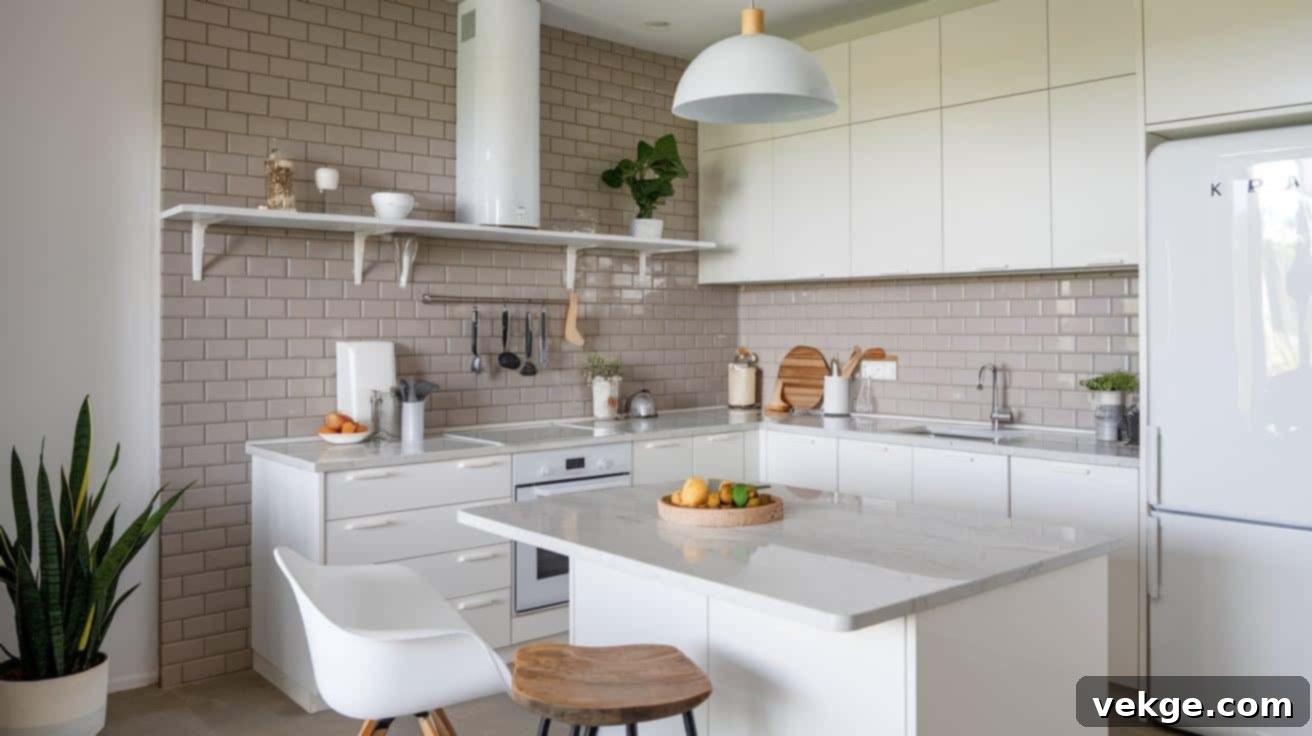
The pairing of classic taupe subway tiles with pristine white cabinets creates an instantly timeless, clean, and inviting look. The subtle, earthy tones of taupe provide a grounding warmth that beautifully complements the crispness of white, preventing the space from feeling too stark or cold. This combination opens up the kitchen, making it feel more expansive and airy, while still adding a layer of sophisticated color.
This design is incredibly versatile, seamlessly fitting into both modern, minimalist kitchens and more traditional, cozy settings. For a modern twist, consider larger format subway tiles or a stacked horizontal pattern. For a traditional feel, opt for standard 3×6 tiles with a slight bevel and a contrasting grout color. The overall effect is a polished aesthetic that works effortlessly in any home, offering enduring appeal and easy integration with various decor styles.
2. Light Taupe Herringbone Tiles with Brass Accents
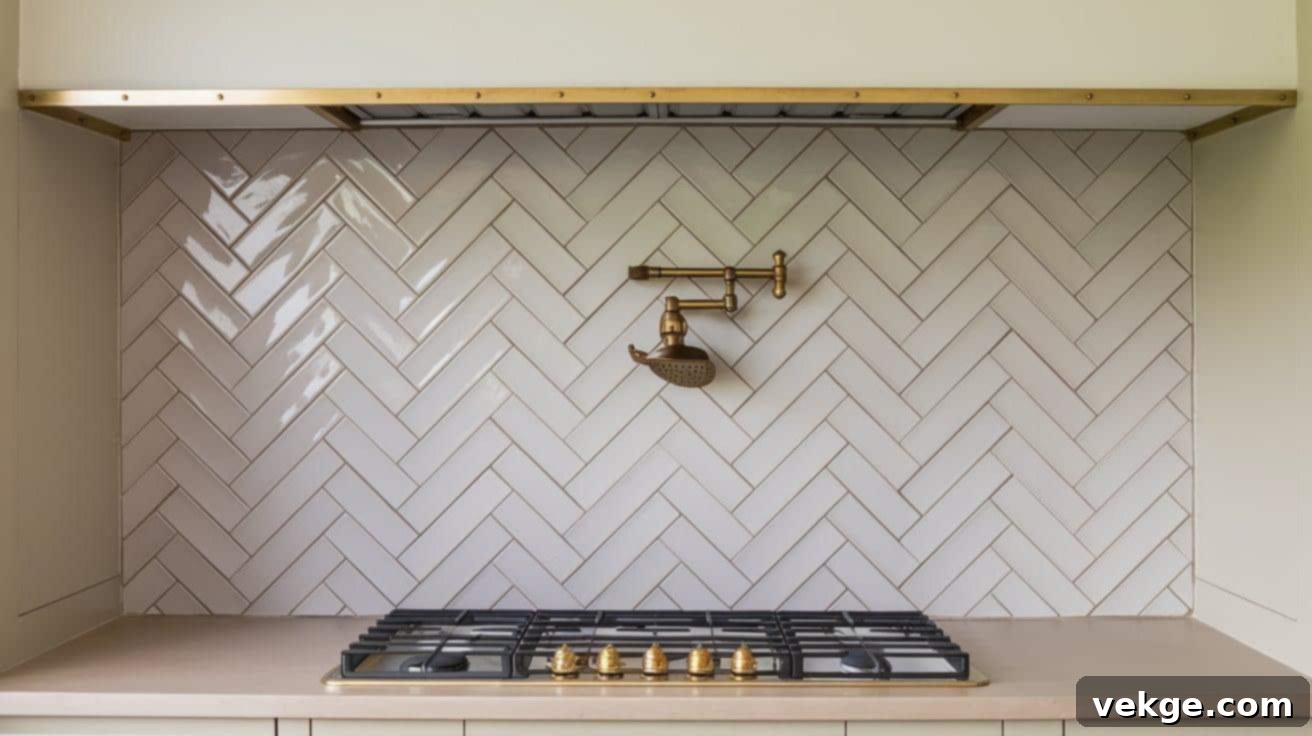
Elevate your kitchen’s style with light taupe herringbone tiles, a design choice that instantly introduces rich texture and captivating depth to your backsplash. The distinctive V-shaped pattern of herringbone creates dynamic visual movement, transforming a simple tile into a stunning focal point. Light taupe, with its airy and gentle quality, ensures the pattern doesn’t overwhelm the space, maintaining a sense of elegance.
To further enhance this sophisticated look, incorporate brass accents through hardware, lighting fixtures, or decorative elements. The warm, metallic glow of brass brilliantly contrasts with the cool undertones of light taupe, injecting a touch of luxurious warmth and high-end style. This combination is ideal for kitchens that seek a more dynamic, stylish, and visually interesting aesthetic, perfect for those who appreciate detailed craftsmanship and a hint of glamour.
3. Dark Taupe Tiles with Contrasting White Countertops
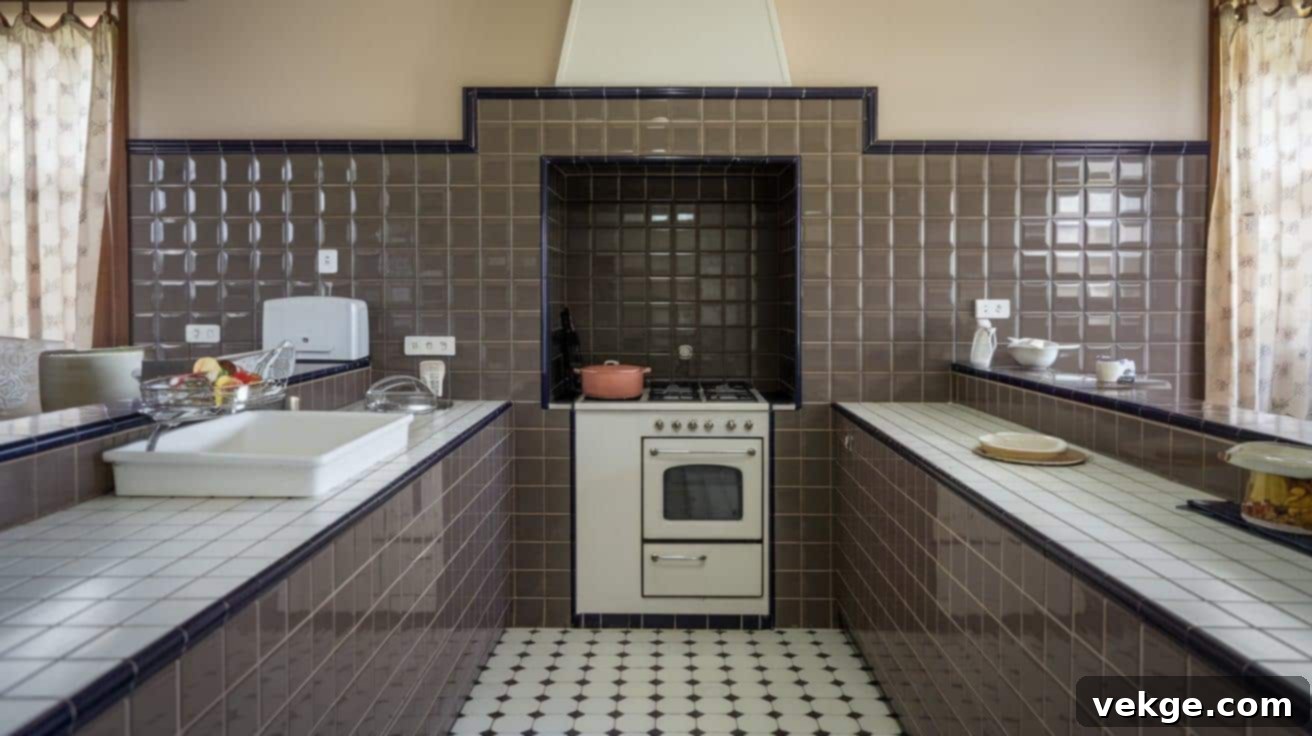
For a bold yet balanced statement, consider dark taupe tiles paired with crisp white countertops. This striking combination creates a strong visual contrast that is both dramatic and harmonious. The deep, rich taupe tones provide a profound sense of warmth and grounding, adding depth and character to the backsplash. Meanwhile, the bright white countertops act as a perfect counterpoint, balancing the intensity of the dark taupe and preventing the space from feeling too heavy or enclosed.
This sophisticated pairing introduces a luxurious and contemporary feel to the kitchen. It’s an excellent choice for those who desire a kitchen with a distinct personality and a touch of modern drama, without sacrificing warmth or elegance. The contrast itself becomes a design feature, highlighting the clean lines of your kitchen and adding a layer of visual interest that is both refined and impactful.
4. Taupe Basketweave Pattern Tiles

Taupe basketweave pattern tiles offer a unique and intricate textured look that immediately draws the eye. This classic pattern, characterized by its interlaced appearance, brings a sophisticated level of detail and craftsmanship to your backsplash. The beauty of the basketweave lies in its ability to combine traditional charm with a modern sensibility, making it a versatile choice for a range of kitchen styles.
The subtle variations within the taupe hue highlight the intricate weaving effect of the tiles, creating a visually appealing surface that is both understated and captivating. This pattern is perfect for adding character, warmth, and a touch of artisanal elegance to your kitchen. It provides rich visual interest without being overly busy, ensuring your kitchen remains refined and inviting. It’s an excellent option for those looking to inject a unique personality into their space while maintaining a timeless appeal.
5. Matte Taupe Tiles for a Rustic, Earthy Look

Embrace a natural, rustic, and profoundly earthy feel in your kitchen with matte taupe tiles. The non-reflective, smooth surface of matte tiles absorbs light rather than bouncing it back, which creates a softer, more subdued aesthetic. This finish enhances the inherent organic quality of taupe, making it an ideal choice for fostering a warm, cozy, and grounded atmosphere.
Matte taupe tiles are perfectly suited for kitchens that lean towards farmhouse, rustic, or bohemian design styles. They exude a sense of calm and authenticity, offering warmth and texture without any flashiness. This choice allows other natural elements in your kitchen, such as wood countertops, exposed beams, or handcrafted pottery, to truly shine. It’s about creating a relaxed, inviting, and homey kitchen where comfort and natural beauty take center stage.
6. Taupe and Gold Tile Combination for a Luxury Feel
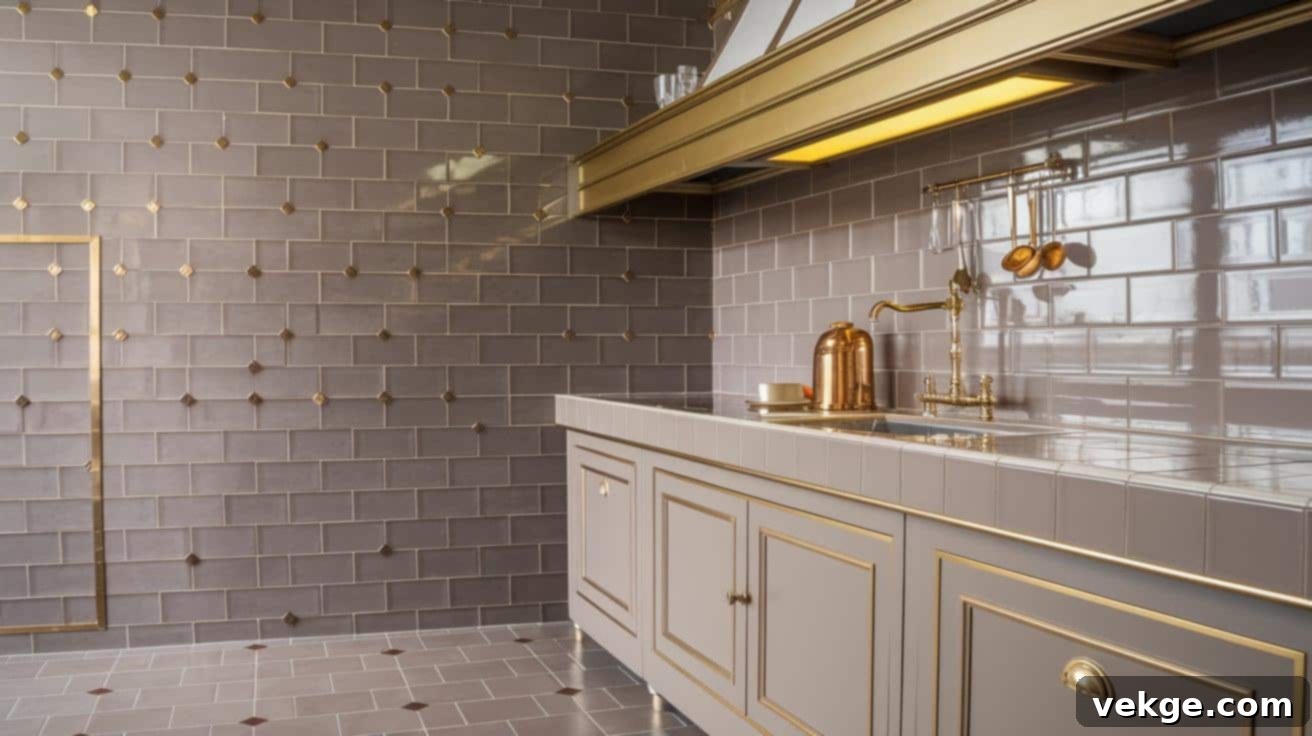
For those seeking to infuse their kitchen with an undeniable sense of luxury and sophisticated glamour, a combination of taupe and gold tiles is an exquisite choice. The rich, deep tones of taupe provide a warm, elegant foundation that perfectly complements the shimmering brilliance of gold accents. Whether through subtle gold veining, interspersed metallic tiles, or decorative gold inlays, this pairing makes the backsplash a truly standout feature.
This opulent combination elevates any kitchen, transforming it into a high-end, stylish sanctuary. The warmth of taupe ensures that the gold elements feel inviting rather than ostentatious, creating a harmonious balance between comfort and grandeur. It’s ideal for homeowners who wish to make a bold yet refined statement, adding a touch of lavishness and creating a kitchen space that feels both extravagant and deeply personal.
7. Taupe Tiles with a Glossy Finish for a Polished Look
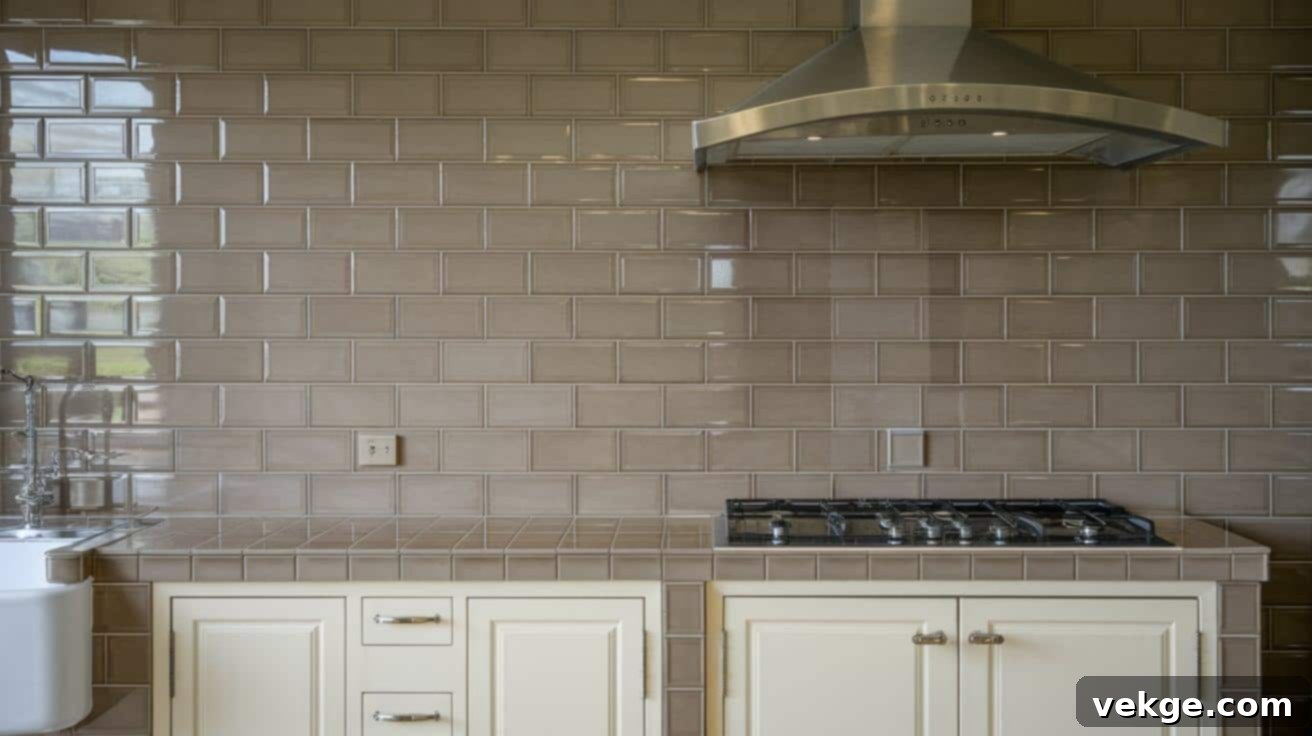
Opting for taupe tiles with a glossy finish is an excellent way to achieve a sleek, highly polished, and bright aesthetic in your kitchen. The reflective quality of the gloss amplifies the natural taupe color, making it appear more vibrant, fresh, and luminous. This finish enhances the depth of the hue and effectively bounces light around the room, which can make smaller kitchens feel larger and more open.
This design choice works particularly well in contemporary and modern kitchens aiming for a clean, sophisticated, and light-filled ambiance. The smooth, shiny surface is also incredibly easy to clean, making it a practical choice for busy households. A glossy taupe backsplash adds an element of subtle glamour, providing a sophisticated backdrop that complements modern appliances and minimalist decor without ever feeling cold or unwelcoming.
8. Taupe Tiles with a Marble Effect
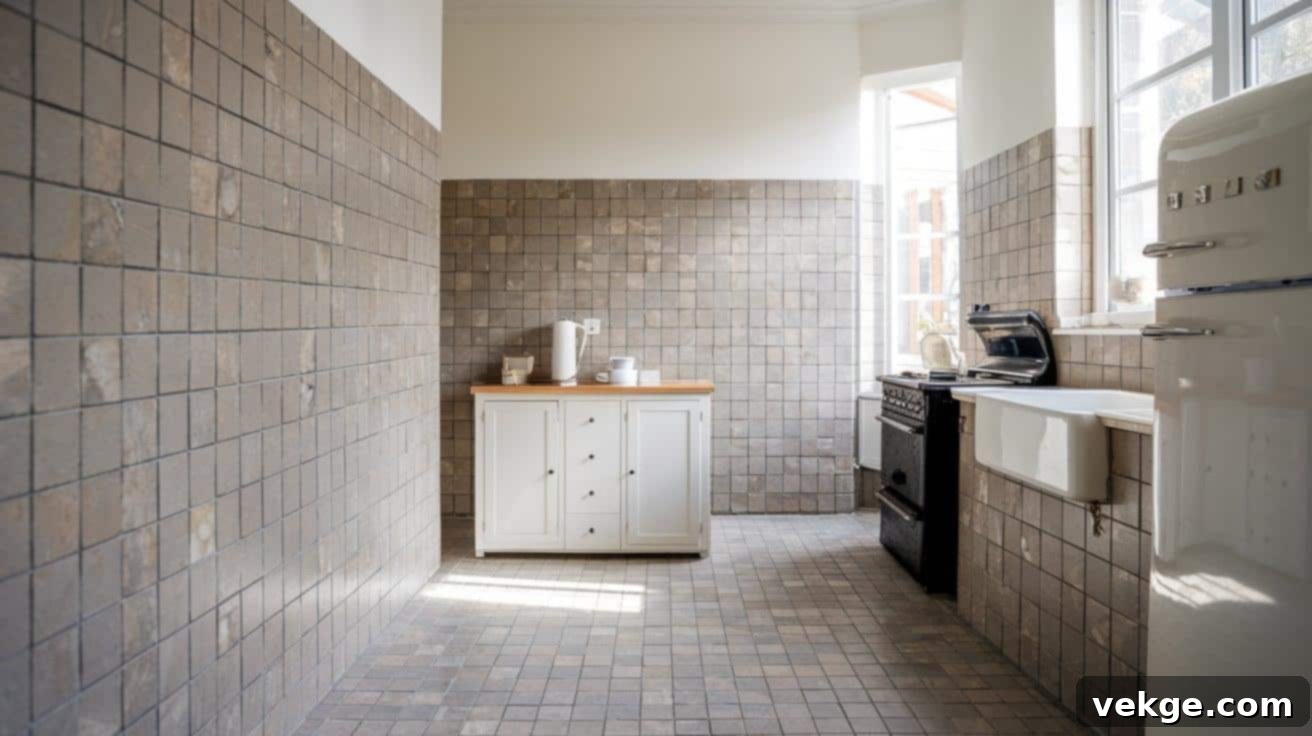
Infuse your kitchen with an air of classic luxury by choosing taupe tiles that feature a marble effect. These tiles are designed to mimic the elegant veining and sophisticated texture of natural marble, offering an enlightened and high-end look without the maintenance or cost often associated with real stone. The subtle, organic patterns of the marble effect add depth and visual interest, elevating the backsplash from a mere surface to a work of art.
This design brilliantly blends the inherent warmth and versatility of taupe with the timeless appeal of marble. The result is a refined and opulent atmosphere that feels both grand and inviting. Taupe marble-effect tiles are perfect for creating a sophisticated kitchen that balances classic beauty with modern sensibilities. They can complement a range of cabinet styles, from shaker white to dark espresso, creating a cohesive and undeniably chic space.
9. Mixing Taupe with Soft Pastels for a Bright, Airy Kitchen
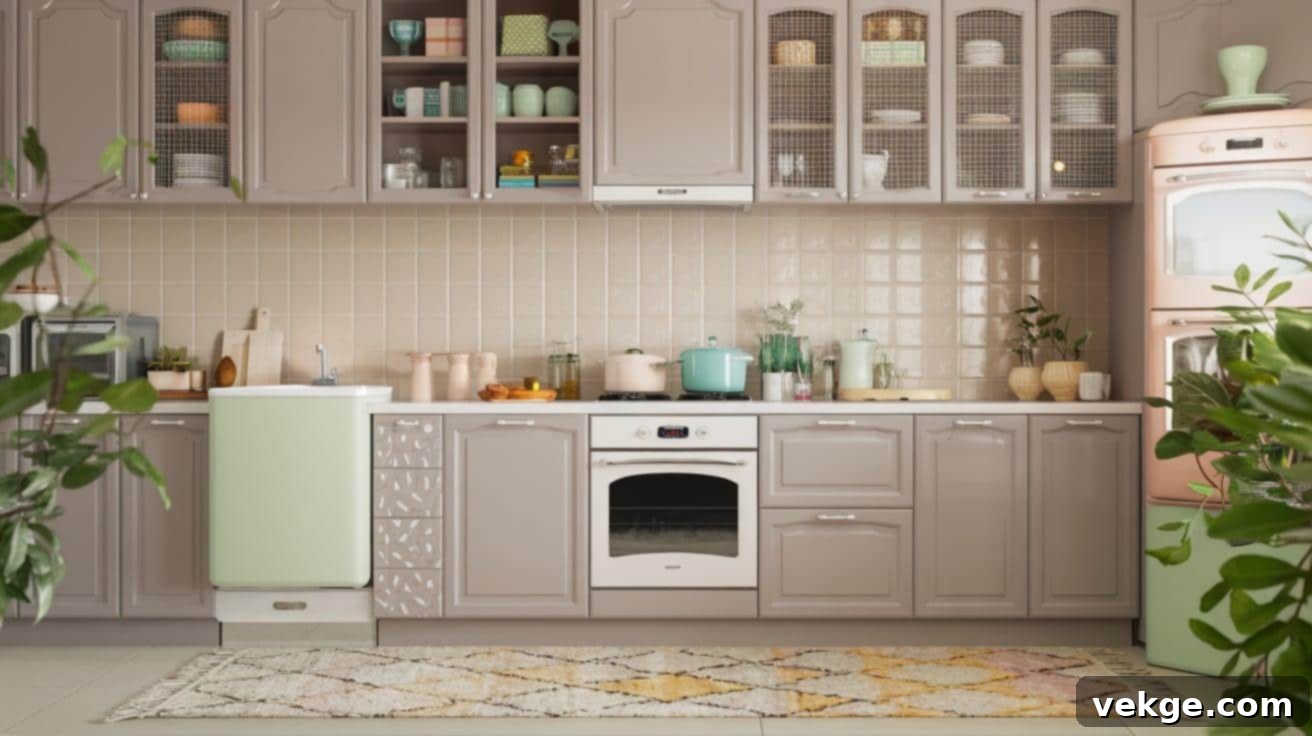
For a kitchen that feels effortlessly bright, light, and full of cheer, consider pairing taupe with soft pastel tiles. This delightful combination creates a serene and welcoming atmosphere, perfect for those who desire a gentle infusion of color. The grounding warmth of taupe acts as a sophisticated anchor for delicate hues like light blue, mint green, blush pink, or soft yellow, preventing the pastels from feeling too saccharine or juvenile.
This palette works exceptionally well in kitchens that aim for a fresh, airy, and inviting look, reminiscent of coastal, shabby chic, or Scandinavian design styles. The soft interplay of colors adds a subtle playful charm while maintaining a high level of sophistication. It’s an ideal choice for creating a kitchen that feels uplifting, calm, and uniquely personalized, offering a refreshing departure from more conventional color schemes.
10. Taupe with Dark Wood Cabinets for Warmth
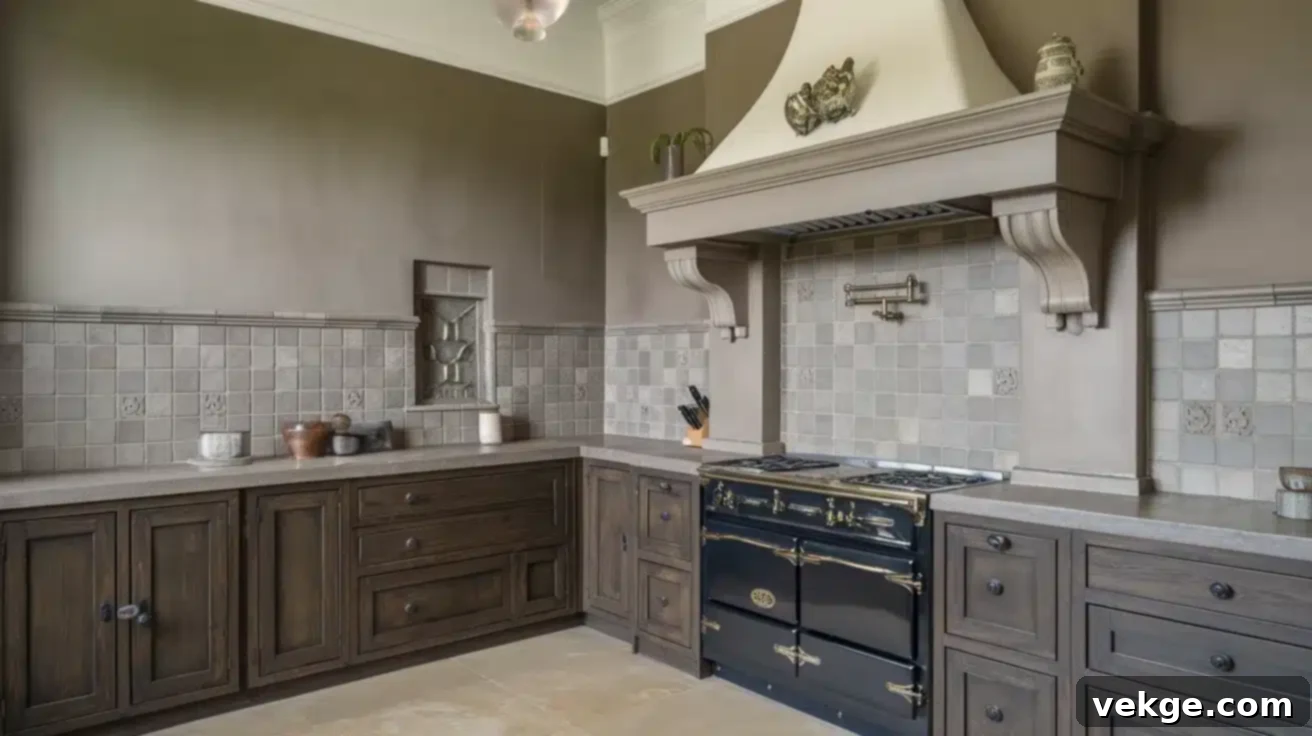
Create a profoundly warm and inviting kitchen by combining taupe backsplash tiles with rich, dark wood cabinets. This classic pairing is a testament to timeless design, where the neutral yet comforting tones of taupe beautifully balance the depth and intensity of dark wood. The contrast between the dark, luxurious wood and the soft, earthy taupe establishes a balanced, grounded, and incredibly cozy atmosphere.
This combination is perfect for kitchens that aspire to feel like a true heart of the home – a space that is both stylish and deeply comforting. It evokes a sense of tradition and natural elegance, preventing the dark cabinets from feeling too heavy or overwhelming. Whether your dark wood is cherry, walnut, or espresso, a taupe backsplash will enhance its natural beauty, adding an element of subtle sophistication and ensuring your kitchen feels both opulent and homely.
11. Taupe with Natural Stone Features
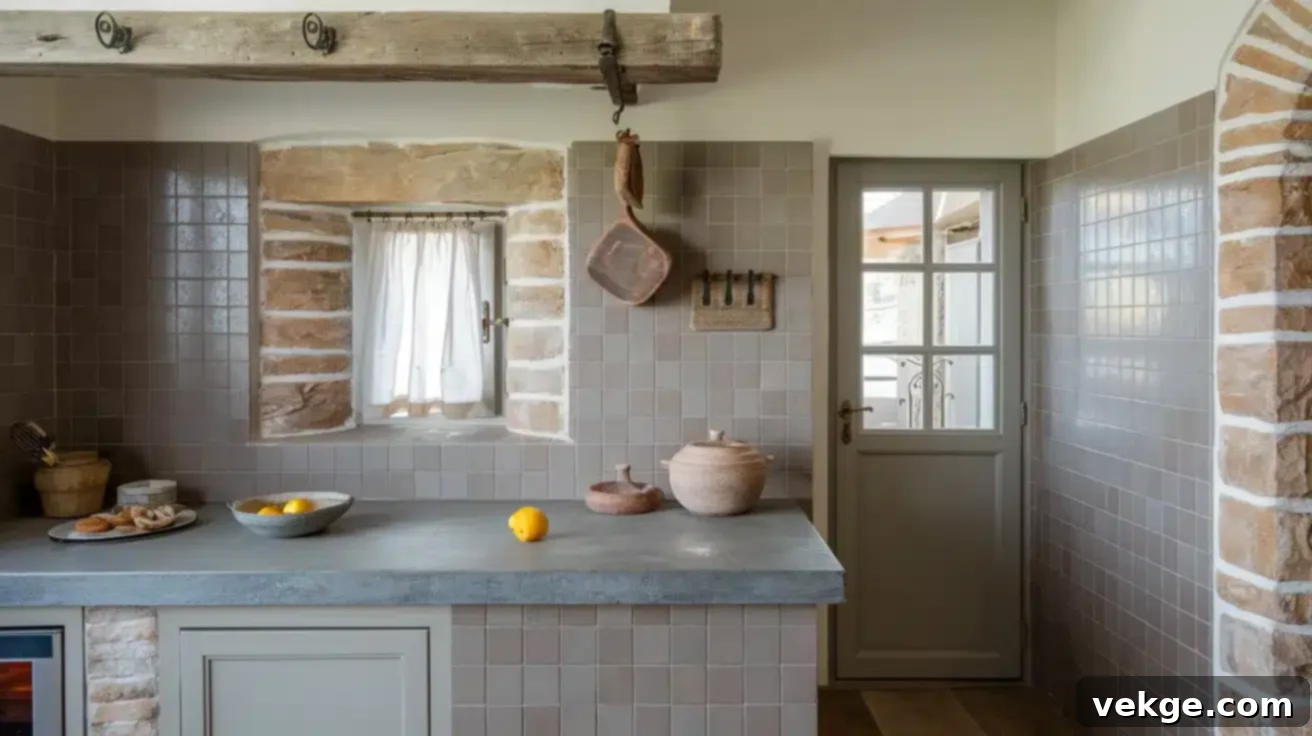
For a kitchen that truly embraces organic beauty and tactile richness, integrate taupe tiles with complementary natural stone features. The inherent earthy tones of taupe naturally harmonize with the rugged, authentic beauty of materials like slate, quartzite, or rough-hewn marble, creating a deeply harmonious and organic feel. This combination brings an unparalleled depth and texture to your kitchen, transforming it into a sensory delight.
This design choice is perfect for kitchens that lean towards a more rustic, nature-inspired, or Mediterranean aesthetic. The varying textures and subtle color shifts between the taupe tiles and natural stone elements create a dynamic visual landscape. It’s about celebrating the imperfections and raw beauty of natural materials, crafting a kitchen that feels authentic, grounded, and intimately connected to the natural world. This approach adds character and timeless elegance, making your kitchen a truly unique space.
12. Geometric Taupe Pattern Tiles
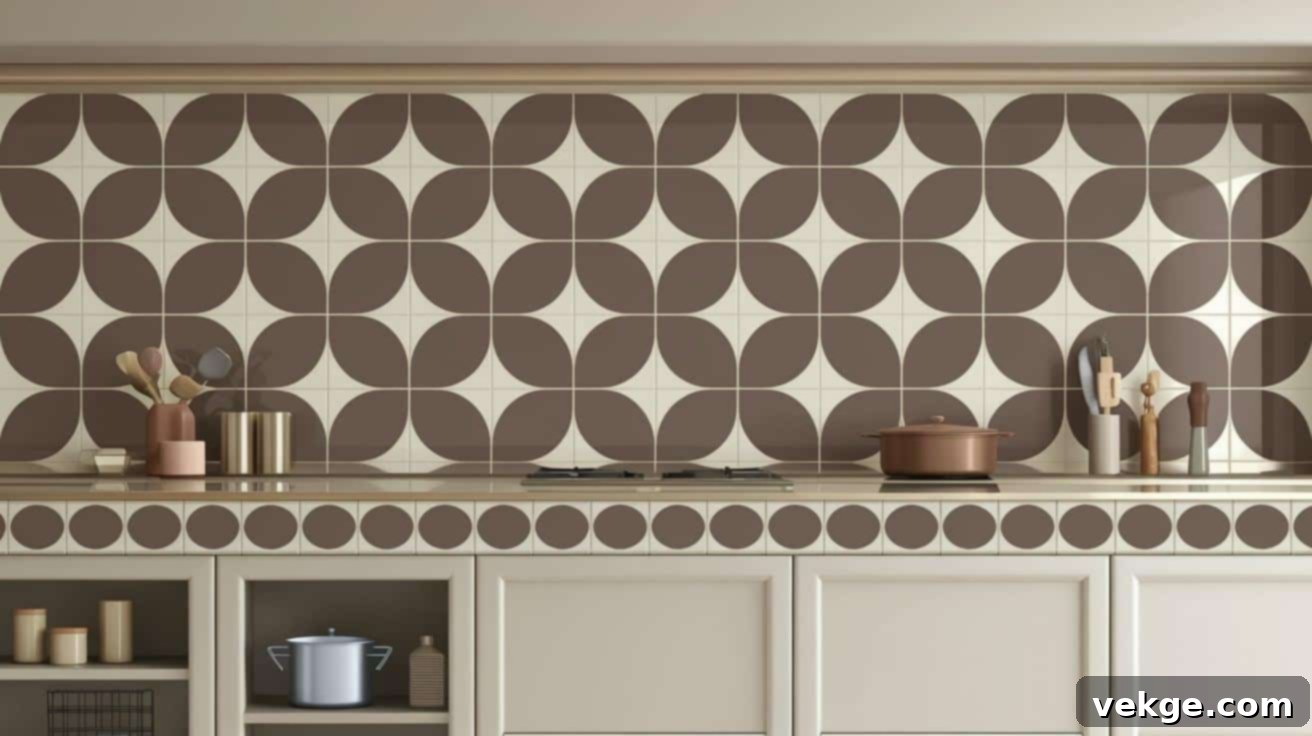
Inject a modern, artistic, and contemporary touch into your kitchen with geometric taupe pattern tiles. Far from being mundane, taupe can be incredibly dynamic when rendered in bold, clean lines and shapes. Patterns like hexagons, arabesques, or even intricate mosaic designs in varying shades of taupe create a unique and visually arresting backdrop, making it an excellent choice for kitchens seeking a distinctive, forward-thinking aesthetic.
This option adds significant visual interest and a sophisticated, innovative flair without ever overwhelming the space. The neutral taupe palette ensures that even complex geometric patterns remain elegant and timeless, rather than becoming trendy or dated. It’s perfect for contemporary kitchens that aim for a curated, art-inspired look, allowing the backsplash to serve as a subtle yet powerful statement piece that showcases personality and modern design sensibility.
DIY Guide: Installing Your Taupe Kitchen Backsplash
Installing a taupe kitchen backsplash yourself is a rewarding project that can significantly enhance your kitchen’s aesthetic with a touch of personal craftsmanship. This detailed DIY guide will walk you through each step of the process, from initial wall preparation to the final grouting and sealing, ensuring you achieve a polished, stylish, and durable finish for your kitchen. With careful planning and attention to detail, you can create a professional-looking backsplash that you’ll be proud of.
Materials & Tools Needed
Before you begin, gather all necessary materials and tools. Having everything on hand will ensure a smooth and efficient installation process. You will need:
- Taupe Tiles: Choose your preferred style, size, and finish.
- Adhesive: Either thin-set mortar (for heavier tiles or uneven surfaces) or mastic (for lighter tiles, easier to work with).
- Grout: Non-sanded grout for narrower joints (<1/8 inch) or sanded grout for wider joints. Choose a color that complements your taupe tiles.
- Tile Spacers: To ensure consistent gaps between tiles.
- Tile Cutter or Wet Saw: Essential for precise cuts around edges, outlets, and corners. A wet saw is recommended for ceramic, porcelain, or stone tiles.
- Notched Trowel: To apply adhesive evenly. The notch size should match your tile size for proper coverage.
- Rubber Float: For pressing grout into the joints.
- Grout Sealer: To protect grout from stains and moisture.
- Level: Crucial for ensuring straight lines and even tile placement.
- Pencil: For marking reference lines.
- Sponge and Buckets: For cleaning tiles and mixing grout.
- Safety Goggles and Gloves: Always wear personal protective equipment.
- Caulk: For sealing edges where the backsplash meets countertops or cabinets.
Step-by-Step Installation Process
Follow these detailed steps to install your taupe backsplash tiles, ensuring a professional, durable, and polished finish for your kitchen.
1. Preparing the Wall Surface
The success of your backsplash installation heavily relies on a well-prepared wall surface. Begin by thoroughly cleaning the wall to remove any grease, dirt, dust, or old adhesive. Use a degreasing cleaner for kitchen walls. Inspect the surface for imperfections; patch any holes, cracks, or uneven areas with spackle or joint compound, then sand smooth once dry. Ensure the wall is completely dry and free of debris. If you have painted walls, lightly sand them to create a better bonding surface for the adhesive. For highly porous surfaces or if using thin-set, applying a tile primer can significantly improve adhesion and prevent the wall from absorbing moisture from the adhesive too quickly, making the installation process more effective and ensuring that the tiles stick securely for the long term.
2. Ensuring Alignment and Applying Adhesive
Proper alignment is key for a professional look. Using a level and a pencil, mark a horizontal reference line across the wall where the bottom edge of your first row of tiles will sit. This line ensures your tiles remain perfectly straight. Mix your adhesive according to the manufacturer’s instructions. Using the appropriate notched trowel, apply the adhesive to a small section of the wall (about 2×2 feet), spreading it evenly. Work in manageable sections to prevent the adhesive from drying out before you can set the tiles – typically you have about 15 to 20 minutes before it skins over. Gently press your taupe tiles into the adhesive, wiggling them slightly to ensure good contact. Insert tile spacers between each tile to maintain consistent gaps for the grout lines, both horizontally and vertically. Periodically check your work with a level to ensure straightness.
3. Cutting Tiles for Edges and Around Outlets
This step requires precision and patience. Measure each space where a tile needs to be cut, especially for edges, corners, and around electrical outlets. For straight cuts, a manual tile cutter can suffice for ceramic or porcelain. For more intricate cuts, L-shaped pieces, or when working with natural stone, a wet saw is indispensable for achieving clean, smooth edges. When cutting around outlets, carefully measure the opening and use a tile nipper or wet saw to create the necessary cut-out. Take your time with each cut, ensuring it fits perfectly to give the backsplash a neat, professional finish. Always remember to wear safety goggles and heavy-duty gloves to protect yourself from tile dust and sharp edges during this process.
4. Grouting, Sealing, and Finishing Touches
Once all tiles are set and the adhesive is completely dry (typically 24-48 hours, depending on the product and humidity), you can begin grouting. Mix the grout according to the manufacturer’s instructions to a peanut butter-like consistency. Using a rubber float, apply the grout diagonally across the tile surface, pressing firmly to work it into all the gaps between the tiles. Ensure the joints are thoroughly filled. After about 15-30 minutes (or as per grout instructions), begin to wipe away excess grout from the tile surface with a damp sponge. Rinse your sponge frequently and work in small sections to prevent the grout from hardening on the tiles. After the grout has fully cured (usually 24-72 hours), apply a high-quality grout sealer. This protective barrier helps to prevent stains, moisture penetration, and mold growth, ensuring your beautiful new taupe backsplash remains pristine for years to come. Finally, apply a bead of caulk along any seams where the backsplash meets the countertop or cabinets for a clean, watertight seal.
Maintenance Tips for Taupe Kitchen Backsplash Tiles
Keeping your taupe kitchen backsplash tiles looking fresh and beautiful requires a simple yet consistent maintenance routine. While taupe is forgiving, proper care will ensure its longevity and aesthetic appeal. Here’s how to maintain your taupe backsplash:
Routine Cleaning: To maintain the everyday freshness of your taupe kitchen backsplash tiles, aim for regular cleaning. For daily tidiness, a quick wipe with a dry microfiber cloth is often enough to remove dust and light debris. For more thorough cleaning or after cooking, use a solution of mild dish soap and warm water. Apply with a soft cloth or sponge, gently clean the tiles, and then wipe dry immediately to prevent water spots. Avoid abrasive cleaners or harsh scrubbing pads, which can damage the tile surface or grout.
Dealing with Stains & Spills: The key to managing spills on your backsplash is immediate action. Blot spills promptly with a clean cloth to prevent them from setting. For common kitchen grease stains, a mixture of warm water and a small amount of dish soap applied with a soft cloth usually works wonders. For food spills or acidic splashes, a diluted white vinegar solution can be effective. For tougher stains, a paste made from baking soda and water can be gently applied, left for a few minutes, and then wiped away. Always rinse the area thoroughly and dry it after treatment.
Protection from Moisture: Moisture is the primary enemy of grout and can lead to discoloration, mold, and mildew. After your taupe backsplash is installed and the grout has fully cured, it is crucial to apply a high-quality grout sealer. This creates a protective barrier that repels water, stains, and dirt. Depending on your sealer type and kitchen usage, reapply the sealer annually or as recommended by the product manufacturer. Always ensure excellent ventilation in your kitchen and wipe up any standing moisture on the backsplash promptly to prevent the growth of unsightly mold and mildew.
Repairing Damage: Even with the best care, accidents can happen. If your taupe backsplash experiences cracks, chips, or crumbling grout, address these issues swiftly to prevent further damage and maintain its appearance. For minor grout issues, clean the affected area and apply new, color-matched grout. For small chips in tiles, a tile repair kit can often fill in the gaps discreetly. For larger cracks or severely chipped tiles, the most effective solution is to carefully remove and replace the individual damaged tile. Always ensure the replacement tile matches your existing ones for a seamless, professional look.
Conclusion: Embrace the Enduring Charm of Taupe Kitchen Backsplash Tiles
Taupe kitchen backsplash tiles truly represent an ideal convergence of warmth, exceptional versatility, and practical low maintenance. This sophisticated neutral hue offers a unique ability to adapt and enhance a vast array of kitchen styles and color schemes, effortlessly transitioning from bright, airy, and contemporary designs to more rustic, cozy, and traditional atmospheres. Its inherent adaptability means that whether you opt for a classic horizontal layout or a modern vertical orientation, taupe will gracefully complement and elevate your space.
The classic and enduring appeal of taupe ensures that your kitchen will remain stylish and relevant for many years to come, proving to be a wise and long-lasting investment in your home’s aesthetic. Beyond its beauty, the practicality of taupe tiles, with their ability to discreetly hide everyday imperfections and their ease of cleaning, makes them an unbeatable choice for any busy household.
So, if you are currently seeking a backsplash solution that is not only profoundly functional but also undeniably beautiful and perpetually chic, taupe tiles emerge as a smart, reliable, and exceptionally rewarding option. Ready to infuse your kitchen with the timeless elegance and versatile charm of taupe? It’s a design decision that promises lasting satisfaction and a kitchen you’ll love for decades.
